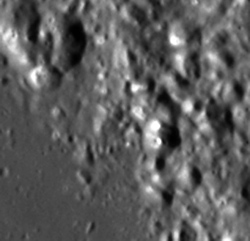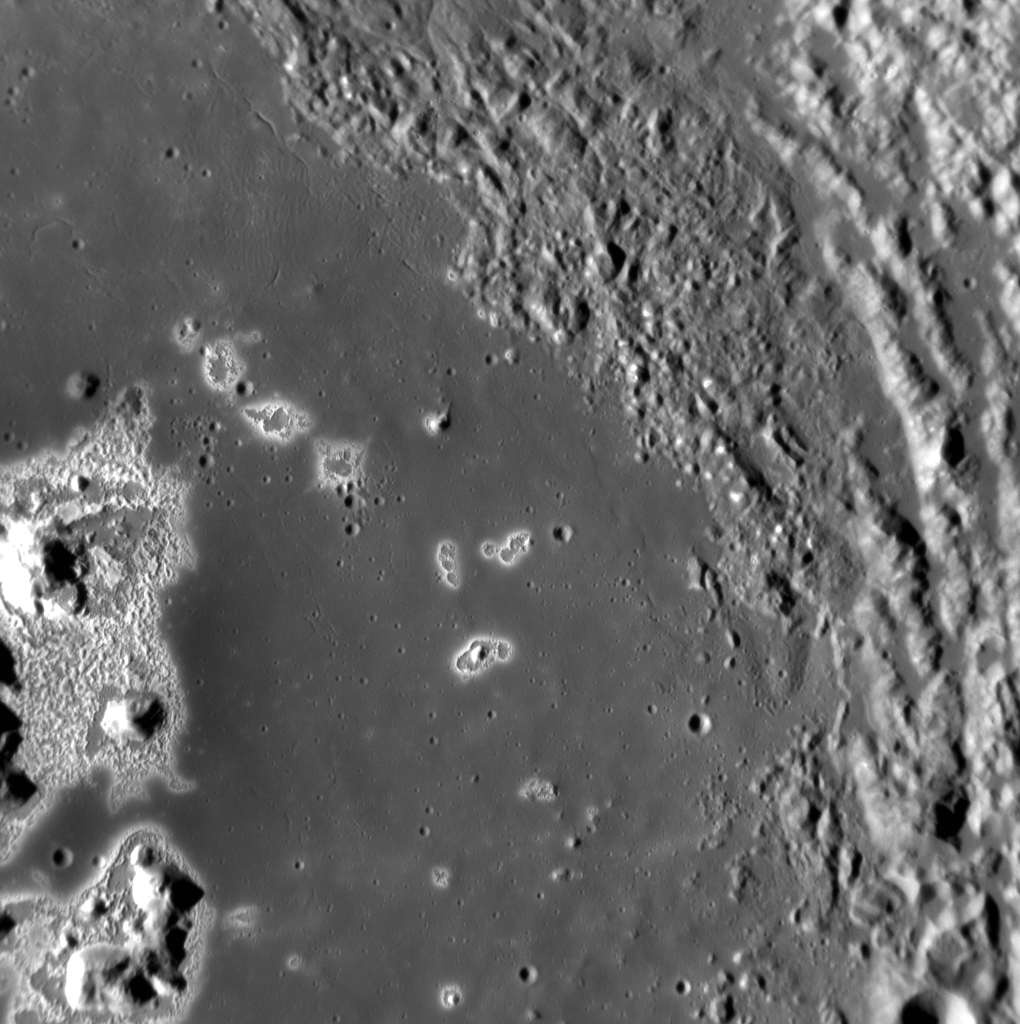MESSENGER targeted-observation image of the interior of Eminescu crater
A recent image acquired by NASA’s MESSENGER spacecraft shows the interior of Eminescu, a youngish 130-km (80 mile) wide crater just north of Mercury’s equator. Eminescu made science headlines last year with MESSENGER’s discovery of curious eroded blotches called “hollows” scattered across its interior and surrounding its central peak, and now it looks like the spacecraft may have spotted some of these strange features in their earliest stages of formation along the inner edge of the crater’s rim.
First announced in September 2011, hollows have now been identified in many areas across Mercury. They had showed up in previous images as only bright spots, but once MESSENGER established orbit in March 2011 and began its high-resolution imaging of Mercury’s surface it soon became clear that these features were something totally new.
The lack of craters within hollows indicates that they are relatively young. It was suggested that they may be the result of an ongoing process on Mercury — a suggestion supported by this recent image, acquired on November 19, 2012.
 In addition to the hollows seen in the smooth central part of the crater and around the base of the central peak, there are also some small bright spots visible within the knobby terrain extending from the base of the crater wall (see detail at right). These bright spots could well be very young hollows, revealing a process in action that is, as far as we know, unique to the planet Mercury.
In addition to the hollows seen in the smooth central part of the crater and around the base of the central peak, there are also some small bright spots visible within the knobby terrain extending from the base of the crater wall (see detail at right). These bright spots could well be very young hollows, revealing a process in action that is, as far as we know, unique to the planet Mercury.
It’s thought that hollows are formed by the solar wind constantly blasting Mercury’s surface, scouring away deposits of volatile materials in its crust that have been left exposed by impacts.
The image above shows an area about 42 km across. Read more on the MESSENGER mission site here.
Image credit: NASA/Johns Hopkins University Applied Physics Laboratory/Carnegie Institution of Washington


I wanted to leave a comment in the article on Uranus in conjunction to the Atlantis asteroid and the comments have been closed
I did a Google search and found that your ‘Atlantis Asteroid’ is at best, the idea that an asteroid destroyed the supposed continent of Atlantis… You might want to look at this or that astrology site instead? This webpage is dedicated to science fact.. not pseudo scientific malarkey…
If there was an “Atlantis”, in the form of a wealthy city on the southern Atlantic coast of Spain, current theories have it having been destroyed by tsunami. Not sure where they all are with that research.
Kind of ‘off topic’ but, from a Wiki look up: “Atlantis (in Greek, ???????? ?????, “island of Atlas”) is a legendary island first mentioned in Plato’s dialogues Timaeus and Critias, written about 360 BC. According to Plato, Atlantis was a naval power lying “in front of the Pillars of Hercules” that conquered many parts of Western Europe and Africa 9,000 years before the time of Solon, or approximately 9600 BC.”
9600 BC, or some 11,600 years ago.. There is some highly debatable evidence that there was possibly a cometary air burst over what is now Canada and is thought to have incinerated much of North America… and wiped out the Clovis people? This occurrence, if eventually proven correct, might have been a civilization destroying event? But this is stretching things a bit far given present info.
This is what I was recalling: http://www.msnbc.msn.com/id/42072469/ns/technology_and_science-science/t/lost-city-atlantis-believed-found-spain/#.UNKQ10JHLA4
Jeez, Jason – you use MSNBC as a credible science source?!
That’s a bit like using TLC, isn’t it?
re- Aqua4U
You were there 11 600 years ago? I
ensures that the discovery of asteroids day examination reveals an
impressive amount of information and especially of correlation with the
corresponding facts has the nature of baptism
Hello Jason ,
I said nothing, I experiment by the experience following the knowledge gained, and I’m very appreciated for sharing my research
I Hello Aqua4U ,
am studying asteroids and astrology and I also like astronomy, there is no harm
“It’s thought that hollows are formed by the solar wind constantly
blasting Mercury’s surface, scouring away deposits of volatile materials
in its crust that have been left exposed by impacts.”
The hollows look to me like some type of volcanism or residual out gassing from buried deposits, possibly cometary in origin?
The leading theory is that they are formed from the sublimation of volatiles. Similar to comets, I suppose, but not sure of the origin of said volatiles.
They remind me of Mandelbrot set images!
http://tiny.cc/g9xlpw
How could it be the solar wind blasting the surface? Mercury has a magnetic field which should deflect it.
Mercury’s magnetic field is only 1.1% as strong as Earth’s mag. field whereas the solar wind at Mercury is on the average three stronger than that at Earth’s orbital distance. This means that a passing CME has quite a bit more punch for Mercury’s small mag. field and can quite readily compress that field down to bombard the surface.
Correct , also a CME has a higher chance of scoring a direct hit on mercury since the probability of a hit goes up geometrically with decrease in distance from the Sun.
It would also be interesting to find out if these hollows get a “refill” at regular intervals from O , H , He etc. in the Solar wind.
Since there is a cavity it would act as a good store for material in the Solar Wind which is continuously banging against Mercuty’s surface due to lack of a practical atmosphere.
Thanks for the explanation. 🙂